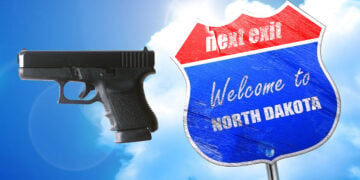Obviously, there are very many pistol sizes and calibers, significant variations in width, height, length, frame, and barrel size dimensions, and large-capacity magazines with double-stack columns. And certainly, there are many individual differences, preferences, medical conditions, felt recoil tolerances, finger lengths, and physical characteristics of shooters. So when seeking the best shooting results (which could include preserving and saving lives), the challenge for everyone is to match his or her personal traits and subjective characteristics and preferences with the pistol’s technical features and characteristics, for the purpose at hand.
The Goal
To properly fit the pistol and its specifications and features to a shooter and his/her physical traits and requirements, rather than solely fitting the comfort level and selected physical trait(s) to a pistol.
Meet Both Objective Technical and Subjective Comfort Factors for Best Pistol Fit
Sadly, many folks are almost totally focused on the comfort and subjective feel of the gun and matching their hands to the pistol. Certainly, these are important. But some do not focus on the primary goal of fitting the pistol and its specifications and features to the shooter’s hands and traits, thus excluding important technical gun features, performance, and key factors of the pistol itself. Often selecting and buying a pistol on the mostly “feel good,” promotional hype, and “latest and greatest” claims aimed at the entire target market. The proper fit means blending all the puzzle pieces together to get the desired result for each unique individual. I strongly believe in “Try Before You Buy.” It is critically important up front to recognize and meet both technical pistol and personal subjective factors when properly selecting and fitting a pistol to a shooter’s unique profile.
Setup Objective Criteria and Requirements
An aimless, willy-nilly “whichever hot pistol is presented to me” approach is not the best plan for getting a pistol to properly match a shooter for accomplishing possible life-saving results. (And I do recognize that a battlefield pickup of another’s gun can happen.) Over many years as a handgun instructor and law professor and practitioner, I have observed that many of the problems experienced by new and experienced shooters is that they do not take the time initially to set their criteria and to fit the pistol’s inherent features and specifications to their particular hands, physical characteristics, and requirements, e.g. medical condition, weak hand strength, finger lengths, and purpose. Certainly, one size does NOT fit all… and all cannot operate all pistols effectively and easily, given their distinctive characteristics, body structure and anatomy.
When making the very important decision about what pistol to carry concealed, or for personal protection, or for that matter using any gun, a shooter should clearly understand the above key goal and several influencing objective and subjective factors for best pistol fit. With this article, I want to give some guidelines to help a shooter establish their personal criteria and to properly match a pistol to their characteristics and the pistol’s characteristics. Note that this article focuses only on pistol fit and match and not for a revolver, although both are related. That is another topic with its considerations.
Initial Safety Precaution
Before a shooter begins to fit a pistol to themself and before following any of the criteria or ideas mentioned here, please first remove the pistol’s magazine to ensure it is empty and then check the gun’s chamber to make certain it is empty and the gun is unloaded. And always follow all the gun safety rules. Safety First Always!
First Know the Basic Guidelines for a Correct Grip
And before being concerned about the technical steps and considerations for a proper fit of a gun to yourself, a shooter should first know the basics of gripping a handgun. This is so very fundamental and influences many other fit, shooting, and accuracy factors. In my recent Concealed Carry and Handgun Essentials book and also in a recent article about this, I included my basic checklist and suggestions for a correct handgun grip for a handgun. It presents the benefits of a proper grip, the problems with the “Teacup” grip and others, the importance of straight alignment, and my eleven steps for a proper grip. See my related article about correctly gripping a pistol here.
Try Before You Buy
Shooters should try any pistol before they buy it not only for accuracy and performance purposes, but for the optimal, custom physical fit and comfort to their hands, fingers, and wrists. There are technical and subjective factors for the shooter to understand to individually and properly fit a pistol to his/her particular hand sizes. Thankfully, many manufacturers recognize this and make interchangeable backstraps in various sizes as a start to help get a better fit for various hands. But there is much more than this to consider and some manufacturers do not offer different sized backstraps.
My 10 Criteria for Proper Pistol Match and Fit
Here are my 10 criteria for properly matching and fitting a pistol to a shooter for Concealed Carry:

1. Easy Operation and Trigger
- Can you grip the pistol correctly, per my above 11 Steps for a Proper Grip?
- Does your trigger finger easily reach the trigger?
(Try to keep your trigger finger at a right angle to the trigger, not resting on the frame.)
- Can you reach and operate the controls, e.g. magazine release, slide stop, safeties, decocker (if applicable), etc.?
- Can you easily operate and rack the slide, per the correct procedure?
(See my Tips for slide racking HERE.)
- Is the trigger press weight and trigger movement manageable for you?
- Can you operate and manage the trigger and overall pistol safely?
(The only place the trigger finger should touch the pistol is on the face of the trigger. It may be necessary for a shooter with short fingers to rotate and adjust their grip to the side to maintain the right angle.)

2. Overall Ergonomics and Comfort Match
- Overall, does the pistol feel good in your hands?
- Can you comfortably and correctly place your finger on the trigger, with minimal if any adjustment?
- Can you get at least two fingers on the grip for a secure pistol grasp?
(Some prefer all three fingers of shooting hand on the grip.)
- Does the pistol have a comfortable grip angle for your preference?
- Does the pistol have a comfortable width for the size of your hands?
- Does the pistol have a good height for the size of your hands and for concealed carry?
- Can you adequately hold and manage the pistol’s weight, especially for carry?
- Can you handle and manage the wide butt of the double-stack pistol?
- Can the shooter comfortably align in a straight line with the sights the wrist bones and the radius and ulna bones of the shooter’s forearm behind the frame to provide resistance against the rearward movement of the frame during recoil?
(If the bore line is significantly offset from the alignment of the wrist and forearm bones, malfunctions may occur.)
3. Concealability and Personal Protection Preferences
- Overall, are the pistol’s specifications optimal and comfortable for your preferences for concealed carry?
(Does the pistol have the correct size dimensions for your physical traits and medical conditions, for concealed carry and/or personal protection?)
- Is the pistol properly fitted and comfortable for your concealed carry holster?
4. Personal Carry Criteria and Compact Pistol Size
- Does the pistol’s dimensions and overall size meet your carry requirements and is it also easy for you to shoot, control, and handle the pistol?
- Do you want to sacrifice performance and/or shootability for a preferred size pistol?
- If you must trade-off, which is your top priority: performance and shootability OR portability and compact size?
5. Controllability and Personal Factors
- Overall, can you effectively control and safely handle the pistol?
- Do you have the physical abilities and medical health to properly and safely handle and operate this pistol?
- Do you have the required strength to operate the pistol and to rack the pistol’s slide?
- Will you need additional training to have the minimum skills to safely operate and shoot the pistol?
6. Defensive Use and Accuracy
- Can you operate this pistol to meet minimum standards (or exceed them) for defensive use and carry accuracy?
- Can you effectively shoot and speedily operate the pistol for close-up tactical self-defense (not for precise bullseye target hits as in competition and long-distance shooting?)
- In emergencies as appropriate and if necessary, can you use one-hand only and the pistol’s rear sight to rack the slide?
7. Reliability
- Can you consistently operate this pistol to meet minimum standards (or exceed them) for defensive use and carry reliability?
- Does the pistol itself work reliably time after time?
- Have you researched the pistol for any possible recalls and problems and, if so, what are the major recalls/problems, and has the manufacturer corrected them?
- Do the mechanical safety/safeties operate and work effectively? And can you easily operate them?
- Is the manufacturer a recognized and respectable handgun manufacturer and do you trust them?
8. Magazine Fit
- Is the magazine single or double stack and is its size, loaded weight, capacity, and configuration appropriate for you to effectively, quickly, and easily load and operate for carry?
- Does the magazine manufacturer offer an extended magazine or pinky-rest extension, so you can better grip and operate the pistol?
9. Caliber and Your Control
- For you, what caliber serves your purpose best? Do you really need a large caliber for your carry purpose? But, will a low-caliber pistol have the stopping power to get the job done? Which caliber can you shoot best and get optimal target hits up close for carry?
- What caliber can you effectively operate and overall control and does it meet your concealed carry needs for accuracy, reliability, and concealability, etc.?
- Is your preferred pistol manufactured in your desired caliber?
- Have you shot your desired caliber to test your accuracy and operational abilities?
10. Proper Training
- Will this pistol require you to have further training to be able to operate and competently shoot it?
- If a new shooter, do you have the training to not only operate and handle the pistol but also to effectively shoot it for acceptable accuracy?
Conclusions
I hope these 10 criteria and my opinions stir your thoughts and help you to best match and fit a pistol and its specifications and features to your subjective factors and personal comfort levels.
Be Safe!
Photos by Author.
* This personal opinion article is meant for general information & educational purposes only and the author strongly recommends that you seek counsel from an attorney for legal advice and your own personal certified weapons trainer for proper guidance about shooting & using YOUR firearms, self-defense and concealed carry. It should not be relied upon as accurate for all shooters & the author assumes no responsibility for anyone’s use of the information and shall not be liable for any improper or incorrect use of the information or any damages or injuries incurred whatsoever.
© 2020 Col Benjamin Findley. All Rights Reserved. This article may not be reprinted or reproduced in whole or in part by mechanical means, photocopying, electronic reproduction, scanning, or any other means without prior written permission. For copyright information, contact Col Ben Findley at [email protected]









